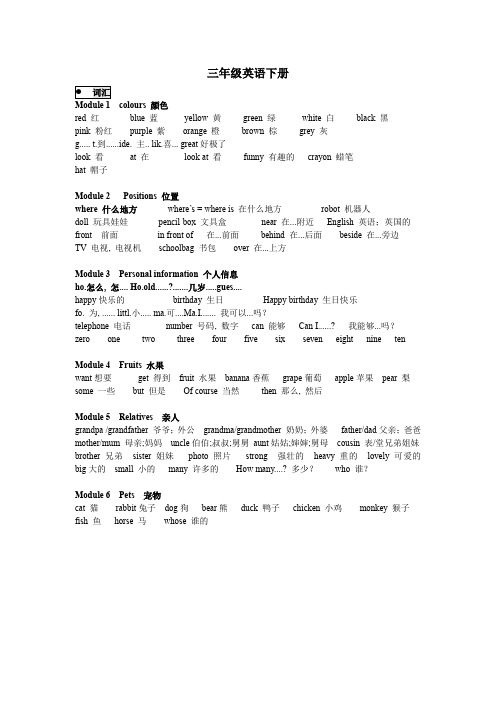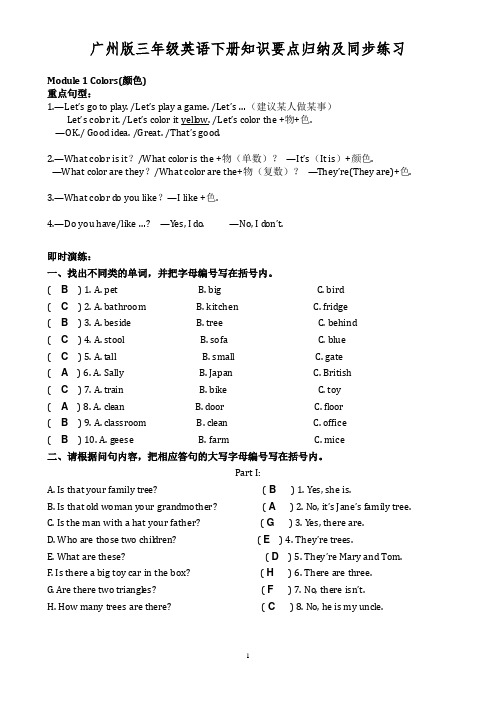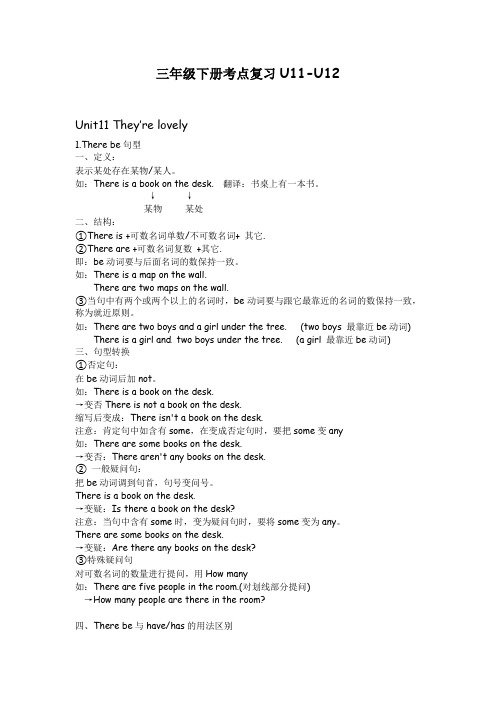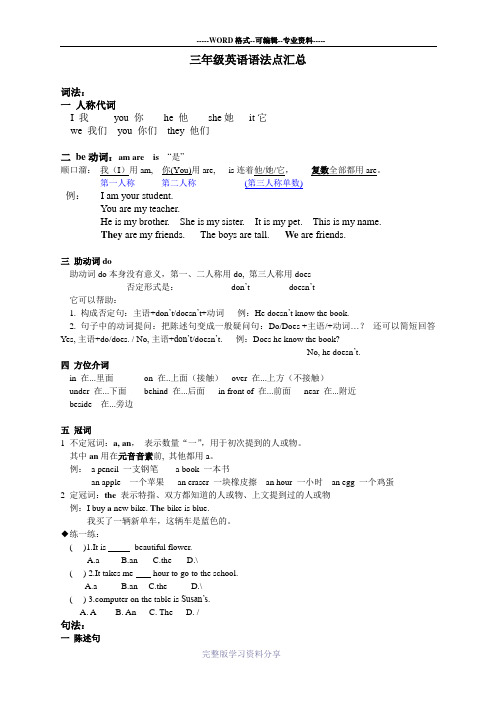最新广州版-三年级英语下册语法汇总
(完整版)广州版三年级自然下册重点语法

(完整版)广州版三年级自然下册重点语法广州版三年级自然下册重点语法第一单元:多样的小动物单数名词变复数- 名词加s,如:cat - cats, dog - dogs- 以s、sh、ch、x结尾的名词,加es,如:bus - buses, brush - brushes- 以辅音字母加y结尾的名词,变y为i,再加es,如:baby - babies, city - cities介词in的用法- 表示位置,如:in the park(在公园里)- 表示时间,如:in the morning(在早上)- 表示状态,如:in trouble(处于麻烦中)一般过去时的用法- 表示过去发生的动作或状态- 表示过去的时间,常和yesterday, last week等时间状语连用- 动词加-ed,如:study - studied, watch - watched数字的表达- 数字1-10: one, two, three, four, five, six, seven, eight, nine, ten- 数字11-20:eleven, twelve, thirteen, fourteen, fifteen, sixteen, seventeen, eighteen, nineteen, twenty第二单元:美丽的昆虫形容词的比较级和最高级- 一般形容词加-er,-est,如:small - smaller - smallest, big - bigger - biggest- 以e结尾的形容词加-r,-st,如:nice - nicer - nicest- 以辅音字母加y结尾的形容词,变y为i,再加-er,-est,如:funny - funnier - funniest数词的表达- 数字21-99:twenty-one, thirty-two, forty-five, seventy-eight等- 数字100以及以上:one hundred, two hundred, three hundred等观察性词语的用法观察性词语用于描述外观、颜色、大小等特征,如:big, small, long, short, black, white等。
广州版-三年级英语下册知识点2

三年级英语下册Module 1 colours 颜色red 红blue 蓝yellow 黄green 绿white 白black 黑pink 粉红purple 紫orange 橙brown 棕grey 灰g..... t.到......ide. 主.. lik.喜... great好极了look 看at 在look at 看funny 有趣的crayon 蜡笔hat 帽子Module 2 Positions 位置where 什么地方where’s = where is 在什么地方robot 机器人doll 玩具娃娃pencil-box 文具盒near 在...附近English 英语;英国的front 前面in front of 在...前面behind 在...后面beside 在...旁边TV 电视, 电视机schoolbag 书包over 在...上方Module 3 Personal information 个人信息ho.怎么, 怎.... Ho.old......?.......几岁.....gues....happy快乐的birthday 生日Happy birthday 生日快乐fo. 为, ...... littl.小..... ma.可....Ma.I....... 我可以...吗?telephone 电话number 号码, 数字can 能够Can I......? 我能够...吗?zero one two three four five six seven eight nine tenModule 4 Fruits 水果want想要get 得到fruit 水果banana香蕉grape葡萄apple苹果pear 梨some 一些but 但是Of course 当然then 那么, 然后Module 5 Relatives 亲人grandpa /grandfather 爷爷;外公grandma/grandmother 奶奶;外婆father/dad父亲;爸爸mother/mum 母亲;妈妈uncle伯伯;叔叔;舅舅aunt姑姑;婶婶;舅母cousin 表/堂兄弟姐妹brother兄弟sister姐妹photo照片strong 强壮的heavy重的lovely可爱的big大的small 小的many 许多的How many....? 多少?who 谁?Module 6 Pets 宠物cat 猫rabbit兔子dog狗bear熊duck 鸭子chicken 小鸡monkey 猴子fish 鱼horse 马whose 谁的1 提议做某事Let’.g.t.play. 我们一起去玩。
三年级下册英语素材知识点归纳 广州版

广州版小学三年级下册知识点归纳Modul e 1 Colors(颜色)重点句型:1.—Let’s go to play. /Let’s play a game. /Let’s …(建议某人做某事)Let’s color it. /Let’s color it yellow. /Let’s color the +物+色.—OK./ Good idea. /Great. /That’s good.2.—What color is it?/What color is the +物(单数)?—It’s(It is)+颜色. —What col or are they?/What color are the+物(复数)?—They’re(They are)+色.3.—What color d o you like?—I like +色.4.—Do you have/like …? —Yes, I d o. —No, I don’t.即时演练:一、找出不同类的单词,并把字母编号写在括号内。
( B) 1. A. pet B. big C. bird( C ) 2. A. bathroom B. kitchen C. fridge( B ) 3. A. beside B. tree C. behind( C ) 4. A. stool B. sofa C. blue( C ) 5. A. tall B. small C. gate( A ) 6. A. Sally B. Japan C. British( C ) 7. A. train B. bike C. toy( A ) 8. A. clean B. door C. floor( B ) 9. A. classroom B. clean C. office( B ) 10. A. geese B. farm C. mice二、请根据问句内容,把相应答句的大写字母编号写在括号内。
广州版三年级英语下册重要知识点整理

广州版三年级英语下册重要知识点整理班级姓名等级Who are the children?—— They are my cousins.Who’s the short girl with black hair?—— She’s my sister.Who’s David Webb?—— He’s my brother.Do you have any cows?—— Yes, I do.Do they have a sister?—— Of course, they do. /Is Susan your sister?—— Yes, she is.Is Jim your uncle?—— Yes, he is.Is her hair long?—— Yes, it is.Is that a bull?—— Yes, it is.Where are you from?—— I am from AustraliaWhere is Janet from?—— She’s from Canada /Where is he from?—— He’s from ChinaAre you Australian?—— Yes, I am.Are you from China?—— Yes, I am.What’s this? —— It’s a bedroom.Where is the chair?—— It’s under the desk .Where is the lamp? ——It’s on the desk.Where is the desk? ——It’s beside the shelf.Is the lamp on the wall?—— No, it isn’t.Is it a stamp?—— No, it isn’t.Are those French stamps?—— Yes, they are.How many beds are there in it?—— There is one.Put the books on the desk. —— OK.Why do you like this toy car?—— Because the toy car is green.Which cars do you like?—— I like the red cars.Is that a building?— No, it’s a house.Are there any trees near the house?—— Yes, there are.Are there any dogs under the chair?—— No, but there is a cat under it.Is there a TV in the living room?—— Yes, there is one on the shelf. / No, there isn’t.Is the swimming pool opposite the clinic? —— Yes, it is. / No, it isn’t. Where is the kitchen?—— It’s downstairs.Where is the lamp? —— It’s on the shelf..1.A: Thank you .B: You’re welcome.2.A: Here’s your juice.B: Thank you.3.A: Come and sit with me on the sofa .B: Thank you.4.A: Put the tape recorder on the shelf.B: OK. / All right.5.Put….on /in…..OK./ All right.按实际情况回答问题:1.Is your mother from Canada?2.Is your father strong?3.Is your school big?4.Is there a TV in your living room?5.Are there any books in your bag?6.Are your bedrooms messy?7.Are you a girl?8.Do you have any pet?9.Who is your English teacher?10.Where is your lamp?11.Where are your exercise books?12.Where are you from?13.Where is your teacher from?14.What’s your name?15.What is this/that?(冰箱)16.What are these/those?(鹅)17.How many rooms are there in your ho18.How many buildings are there in your school?19.What colour is your bag?20.What colour is your pencil-case?21.Do you have a sister?22.Do you have a dog?23.Do you like China?24.Is your father tall?25.Is your mother beautiful?26.Where is your bag now?27.Where are your exercise books?28.Is there a TV in your living room?29.Is there a computer in your classroom?30.Are there any desks in your classroo31.Are there any books in your bag?32.Is your bedroom upstairs?33.Is your classroom dowstairs?34.Let’s clean the blackboa35.Wash your hands.36.Brush your hair,please37.Give the stamp to me, plea38.Please lend me your rul39.Here’s my ruler40.Here’s the tissue43. How many books are there in youbag?问“你、他们、….”有什么….? Do you have any pencils?Yes,I do.\No,I don’t. 练习:1.He_______ a toy car. And I ______ a toy plane.2.She ______ some red rulers. My brothers ________ some yellow rulers.3.They ______ two pencils4.The children ______ a big bedroom.5.The lady______ two daughters.6.My father _______ a car.7. The goldfish ______ a beautiful tail.8My bedroom ________ two windows.9. The table _____ four legs.10. Do you _________ any boxes ? No, I _______11. Do they _________ a house? Yes,they_____.五. (存在“有”)there be 句型(1)There be 句型表示:在某地有某物(或人)(2)在there be 句型中,主语是单数,be 动词用is ; 主语是复数,be 动词用are ; 如有几件物品,be 动词根据最近be 动词的那个名词决定。
广州版 三年级英语下册知识点

三年级英语下册Module 1 colours 颜色red 红blue 蓝yellow 黄green 绿white 白black 黑pink 粉红purple 紫orange 橙brown 棕grey 灰go 去to 到、、、idea 主意like 喜欢great好极了look 瞧at 在look at 瞧funny 有趣的crayon 蜡笔hat 帽子Module 2 Positions 位置where 什么地方where’s = where is 在什么地方robot 机器人doll 玩具娃娃pencil-box 文具盒near 在、、、附近English 英语;英国的front 前面in front of 在、、、前面behind 在、、、后面beside 在、、、旁边TV 电视,电视机schoolbag 书包over 在、、、上方Module 3 Personal information 个人信息how 怎么,怎样How old、、、、、、?、、、、、、几岁? guess 猜happy快乐的birthday 生日Happy birthday 生日快乐for 为,给little 小的may 可以May I、、、、、、? 我可以、、、不?telephone 电话number 号码,数字can 能够Can I、、、、、、? 我能够、、、不?zero one two three four five six seven eight nine tenModule 4 Fruits 水果want想要get 得到fruit 水果banana香蕉grape葡萄apple苹果pear 梨some 一些but 但就是Of course 当然then 那么,然后Module 5 Relatives 亲人grandpa /grandfather 爷爷;外公grandma/grandmother 奶奶;外婆father/dad父亲;爸爸mother/mum 母亲;妈妈uncle伯伯;叔叔;舅舅 aunt姑姑;婶婶;舅母cousin 表/堂兄弟姐妹brother兄弟sister姐妹photo照片strong 强壮的heavy重的lovely可爱的big大的small 小的many 许多的How many、、、、? 多少?who 谁?Module 6 Pets 宠物cat 猫rabbit兔子dog狗bear熊duck 鸭子chicken 小鸡monkey 猴子fish 鱼horse 马whose 谁的1 提议做某事Let’s go to play、我们一起去玩。
广州版三年级英语下册知识要点归纳及同步练习

广州版三年级英语下册知识要点归纳及同步练习Module 1 Colors(颜色)重点句型:1.—Let’s go to play. /Let’s play a game. /Let’s …(建议某人做某事)Let’s col or it. /Let’s col or it yellow. /Let’s color the +物+色.—OK./ Good id ea. /Great. /That’s good.2.—What col or is it?/What col or is the +物(单数)?—It’s(It is)+颜色. —What col or are they?/What col or are the+物(复数)?—They’re(They are)+色.3.—What col or d o you like?—I like +色.4.—Do you have/like …? —Yes, I d o. —No, I d on’t.即时演练:一、找出不同类的单词,并把字母编号写在括号内。
( B) 1. A. pet B. big C. bird( C ) 2. A. bathroom B. kitchen C. fridge( B ) 3. A. besid e B. tree C. behind( C ) 4. A. stool B. sofa C. blue( C ) 5. A. tall B. small C. gate( A ) 6. A. Sally B. Japan C. British( C ) 7. A. train B. bike C. toy( A ) 8. A. cl ean B. d oor C. fl oor( B ) 9. A. classroom B. cl ean C. office( B ) 10. A. geese B. farm C. mice二、请根据问句内容,把相应答句的大写字母编号写在括号内。
【知识点详细总结】广州教科版三年级下册英语 Module 6 Pets

三年级下册考点复习U11-U12Unit11 They’re lovely1.There be句型一、定义:表示某处存在某物/某人。
如:There is a book on the desk. 翻译:书桌上有一本书。
↓↓某物某处二、结构:①There is +可数名词单数/不可数名词+ 其它.②There are +可数名词复数+其它.即:be动词要与后面名词的数保持一致。
如:There is a map on the wall.There are two maps on the wall.③当句中有两个或两个以上的名词时,be动词要与跟它最靠近的名词的数保持一致,称为就近原则。
如:There are two boys and a girl under the tree. (two boys 最靠近be动词) There is a girl and two boys under the tree. (a girl 最靠近be动词)三、句型转换①否定句:在be动词后加not。
如:There is a book on the desk.→变否There is not a book on the desk.缩写后变成:There isn't a book on the desk.注意:肯定句中如含有some,在变成否定句时,要把some变any如:There are some books on the desk.→变否:There aren't any books on the desk.②一般疑问句:把be动词调到句首,句号变问号。
There is a book on the desk.→变疑:Is there a book on the desk?注意:当句中含有some时,变为疑问句时,要将some变为any。
There are some books on the desk.→变疑:Are there any books on the desk?③特殊疑问句对可数名词的数量进行提问,用How many如:There are five people in the room.(对划线部分提问)→How many people are there in the room?四、There be与have/has的用法区别①结构不同:There be + 名词+其它.主语+ have/has + 其它.②意义不同there be表示“存在”have/has表示“持有/拥有”③两者不可混用(X) There is have ....(X) There have are ....试对比:第一组:There are some apples in the box.盒子里有一些苹果。
广州版-三年级英语下册语法汇总

三年级英语语法点汇总词法:一人称代词I 我you 你he 他she她it它we 我们you 你们they 他们二be动词:am are is “是”顺口溜:我(I)用am, 你(You)用are, is连着他/她/它,复数全部都用are。
第一人称第二人称(第三人称单数)例:I am your student.You are my teacher.He is my brother. She is my sister. It is my pet. This is my name.They are my friends. The boys are tall. We are friends.三助动词do助动词do本身没有意义,第一、二人称用do, 第三人称用does否定形式是:don’t doesn’t它可以帮助:1. 构成否定句:主语+don’t/doesn’t+动词例:He doesn’t know the book.2. 句子中的动词提问:把陈述句变成一般疑问句:Do/Does +主语/+动词…?还可以简短回答Yes, 主语+do/does. / No, 主语+don’t/doesn’t. 例:Does he know the book?--No, he doesn’t.四方位介词in 在...里面on 在..上面(接触)over 在...上方(不接触)under 在...下面behind 在...后面in front of 在...前面near 在...附近beside 在...旁边五冠词1 不定冠词:a, an,表示数量“一”,用于初次提到的人或物。
其中an用在元音音素前, 其他都用a。
例:a pencil 一支钢笔 a book 一本书an apple 一个苹果an eraser 一块橡皮擦an hour 一小时an egg 一个鸡蛋2 定冠词:the表示特指、双方都知道的人或物、上文提到过的人或物例:I buy a new bike. The bike is blue.我买了一辆新单车,这辆车是蓝色的。
广州版英语三年级下语法讲析

广州版英语三年级下语法讲析一.可数名词变复数的规则1.一般情况,直接在名词后面加―s‖. 如: bed – beds cat—cats2.以― s, x, sh, ch‖ 结尾,在后面加― es ‖. 如: bus—buses box—boxesglass—glasses3.以辅音字母+y 结尾的名词, 改y变i再加es. 如: baby—babies study—studieslady—ladies4.特殊情况,不规则:①复数不变:sheep—sheep fish—fish goldfish—goldfish②不规则:mouse—mice child—children foot—feet tooth—teeth man—men woman—women◆不可数名词(不加s)hair---头发juice---果汁people---人water---水练习:填入所给名词的正确形式:1. I have two____________ (apple)2. There are many ___________ here. (box)3. There are many ___________ on the desk. (bus)4. Some ___________ are drawing on the wall. (boy)5. The ______________ are playing football now. (child)6. Please take two _______________ for me. (photo)7. I like the three red ________________.(pencil)8. Would you please clean your _____________ now? (tooth)9. Do you want some _________? (milk)10. There are ten __________ in the shop. (rabbit)二.―是(be)‖动词有三个:am are is第一人称单数:I — am 第二人称单数:you — are第三人称单数:he,she,it — is 全部复数都用:are注意不可数名词:Is there any water on the table ?Is there any orange juice in the glass?练习:用is,am,are填空。
广州版三年级英语下册重点语法(可编辑修改word版)

三、归纳some和any的用法指引。
some和any的中文解释都是:陈述句里的一些是用:
否定句和疑问句里的一些是用:
过关练习:
1.Jackhas
( some,any)dogs.But I don’thave
( some, any )dogs.
2.Thereare(some, any) bedrooms in thehouse.
2.Therebe结构一般用在句子的开头, 而have等词只能用于某一个主语后面。
1.(有)abookinthedesk.2.(有)atoy on your bed.
3.I(有)abike.4.They(有)abike5.Myfather(有)acar.
四、(拥
have的基本意思相当于汉语的“拥有”。例如:I have a book.
11.Dotheya house?Yes,they.
一、知识归纳:have和has的使用规律:(两个都解释为:“有”)我有、你有、复数名词有用:。
你、我之外单数名词有用:。
否定、疑问句无论谁有都用:。
过关巩固:
1.Iadog.2.Shesomepictures.
2.3.Myuncleablackcar.4.Doyouanybooks?
3.Doyouhave(some, any)cats?
4.Doyouhave(some, any) cousins? Yes, I do. 5.Dothey(some, any) any brothers? No, theydon’t.
6.Idon’thave(some, any) any ducks. ButIhavesomecards.
广州版小学三年级下册英语期末复习资料(单词、句型、语法)

小学英语三年级第二学期单词默写表Class______ Name __________ Unit One树谁谁是她她是祖母;外婆;奶奶祖父;外公;爷爷对的女儿父亲;爸爸母亲;妈妈兄弟姐;妹叔叔;舅舅;大伯;姨;姑姑儿子他他是那么;如此他的表、堂兄弟、姐妹Unit Two老的;旧的有;和……在一起关于……呢?美丽的妇女漂亮的;美丽的高的男人矮的;短的那些男孩女孩看……逗人喜欢的婴儿她的强壮的长的Unit Four有农场助动词,没有特别意思一些;某些;任何有猪一些;某些大的牛;母牛;奶牛在这儿。
鸭子鹅鹅(复数)鸡山羊不;不对;没有绵羊马喜欢狗猫Unit Five宠物小的尾巴鱼家兔Unit Seven从;来自美国;美利坚合众国邮票美国的;美国人;美国人的中国的;中国人;中国人的;汉语火车仅仅;唯一的大不列颠的;英国人加拿大的;加拿大人;加拿大人的Unit Eight中国我们我们是(两者)都不列颠;英国中华人民共和国玩具Unit Ten画(画)卧室门窗当然地板;地下;层墙凳子Unit Eleven放哪一个;哪些在……旁边他(它)们(宾格)在……下面地图灯;台灯电视;电视机钟在……前面在……旁边在……后面Unit Thirteen来进来。
看厅;起居室坐厨房玻璃;玻璃杯Unit Fourteen英格兰;英国可爱的浴室看一看计算机书房;学习电冰箱Unit Sixteen清洁;清洁的课室练习练习本在……(两者)中间老鼠老鼠(复数)在……附近黑板小的Unit Seventeen我们的学校大楼;建筑物办公室教师办公室厕所;洗手间大门游泳池单词归类grandfathergrandmotherfathermotheruncleauntsisterbrothercousinhusbandwifesondaughterchickengoose(复数geese)froggoatrabbitgoldfishcatsheeppighorsecowbulldogchickduckmouse(复数mice)fishbirdturtleguinea pigspiderPRC/ChinaUSA/AmericaUK/England/BritainGermanyFranceCanadaAustraliaJapanChineseAmericanBritish/EnglishGermanFrenchCanadianAustralianJapanesebedwardrobesofachairdeskstooltablecupboardshelffloordoorwindowwallceilingbedroombathroomstudykitchenliving roomgardengarageupstairsdownstairsbuildinglibraryteachers’ roomswimming poolheadmaster’s officeplaygroundclinicclassroomtoiletgatecanteen school office flowerbed statueonunderin besideby againstin front of behind near between oppositepainting picture map clock lamp fridgeTV computerman woman ladyboygirlbabybeautiful pretty slimcute strong longtallshortoldbigsmall little lovelycleansitdrawlikelooklook athave a lookputwhichwhowherewhathow many三年级下学期常见句子配对Module 1 & Module 2:Who are the children?——They are my cousins.Who’s the short girl with black hair?——She’s my sister.Who’s David Webb?——He’s my brother.What’s that?——It’s my family tree. / It’s a pig.Do you have any cows?——Yes, I do. / No, I d on’t.Do they have a sister?——Of course, they do. / No,they don’t.Is Susan your sister?——Yes, she is. / No, she isn’t.Is Jim your uncle?——Yes, he is. / No, he isn’t.Is her hair long?——Yes, it is. / No, it isn’t.Is that a bull?——Yes, it is. / No, it isn’t.Module 3 & Module 4:Where are you from?——I am from Australia / America /England …Where is Janet from?——She’s from Canada / Japan /Germany …Where is he from?——He’s from China / France …Are you Australian?——Yes, I am. / No, I am not.Are you from China?——Yes, I am. / No, I’m not.What’s this? ——It’s a bedroom.Where is the chair?——It’s under the desk .Where is the lamp? ——It’s on the desk.Where is the desk? ——It’s beside theshelf.Is the lamp on the wall?——Yes, it is. / No, it isn’t.Is it a stamp?——Yes, it is. / No, it isn’t.Are those French stamps?——Yes, they are. / No, they aren’t.How many beds are there in it?——There is one.Do you have a Japanese bike?——Yes, I do. / No, I d on’t.What are these?——They are Canadian stamps.Put the books on the desk. ——OK.Why do you like this toy car?——Because the toy car is green.Which cars do you like?——I like the red cars.Module 5 & Module 6Is that a building?——Yes, it is. / No, it’s a house.Are there any trees near the house?——Yes, there are. / No, there are n’t.Are there any dogs under the chair?——Yes, there are. / No, but there isa cat under it.Is there a TV in the living room?——Yes, there is one on the shelf. /No, there isn’t.Is the swimming pool opposite the clinic?——Yes, it is. / No, it isn’t.Where is the kitchen?——It’s downstairs.Where is the lamp? ——It’s on the shelf.重要句子1.Is this/that/it ….?Yes, it is. / No, it isn’t.2.Is he/she ….?Yes, he/she is.No, he/she isn’t.3.Is there …..?Yes, there is.No, there isn’t.4.Are these/those/they?Yes, they are.No they aren’t.5.Are there …..?Yes, there are.No, there aren’t.6.Are you …?Yes, I am. / No, I’m not.7.Do you …..?Yes, I do. / No, I don’t.8.Who is he/she ?He /She is ….9.Who are they?They’re….10.What are these/those/they?They’re…..11.What’s your name ?I’m…..12.What is this/that/it ?It’s ……13.What colour is ….?It’s….14.What colour are ---?They’r ---15.Where are you from?I’m from …..16.Where is he/she from?He/She is from…..17.Where are they from?They’re from ….18.Where is ….?It’s in/on/under…..19.Where are …..?They’re in/on/under…..20.How many …are there?单数:There is one.复数:There are….1.A: Thank you .18.How many buildings are there in yourschool?19.What colour is your bag?______________________________20.What colour is your pencil-case?______________________________21.Do you have a sister?______________________________22.Do you have a dog?______________________________23.Do you like China?______________________________24.Is your father tall?______________________________25.Is your mother beautiful?______________________________26.Where is your bag now?______________________________27.Where are your exercise books?______________________________28.Is there a TV in your living room?______________________________29.Is there a computer in your classroom?______________________________30.Are there any desks in your classroom?______________________________31.Are there any books in your bag?______________________________32.Is your bedroom upstairs?______________________________33.Is your classroom dowstairs?______________________________34.Let’s clean the blackboard.______________________________35.Wash your hands.______________________________36.Brush your hair,please.______________________________37.Give the stamp to me, please______________________________38.Please lend me your ruler.______________________________39.Here’s my ruler.______________________________40.Here’s the tissue.______________________________41.Thank you.______________________________42.How are you?______________________________ 43.How many books are there in your bag?44.What is in your bag?语法知识一.可数名词变复数的规则1.一般情况,直接在名词后面加“s‖. 如: bed – beds cat—cats2.以― s, x, sh, ch‖ 结尾,在后面加― es‖. 如: bus—busesbox—boxes glass—glasses3.以辅音字母+y 结尾的名词, 改y变i再加es. 如: baby—babiesstudy—studies lady—ladies4.特殊情况,不规则:①复数不变:sheep—sheep fish—fishgoldfish—goldfish②不规则:goose—geese mouse—mice child—children shelf—shelves tooth—teeth man—men woman—women◆不可数名词(不加s)hair---头发 juice---果汁 tissue---纸巾 chalk---粉笔 water---水二.―是‖动词有三个:am are is第一人称单数:I — am 第二人称单数:you — are第三人称单数:he,she,it — is 全部复数都用:are注意不可数名词:Is there any tissue on the table ?Is there any orange juice in the glass?三.some 和anysome 和any 的主要区别为:some和any都表示“一些”,但是“some”用于肯定句,any用于否定句(not;n’t)和疑问句(?)。
最新广州版三年级英语下册重点语法

姓名年级性别课题there be 句型的运用教学目标there be 句型的肯定句、否定句和疑问句运用难点重点there be句型与have(has) 的区别过程语法知识讲解与复习一、there be句型(1)There be 句型表示:在某地有某物(或人)(2)在there be 句型中,主语是单数,be 动词用is ; 主语是复数,be 动词用are ; 如有几件物品,be 动词根据靠最近be 动词的那个名词决定。
例如:1. There is a pen on the desk. 书桌上有一支钢笔。
2. There are two books on the desk.书桌上有两本书。
3. There is a pen and two books on the desk. 书桌上有一支钢笔和两本书。
4. There are two books and a pen on the desk.书桌上有两本书和一支钢笔。
题型巩固:1.There _____ an apple on the desk.2.There _____many cars under the tree.3..There _____ a ruler , two books and five pictures on the desk.(3)there be 句型要变成:@否定句时,在be 动词后加not;@一般疑问句时,把be 动词调到句首。
例如:1.否定句:There is not a box on the table. 饭桌上没有一个盒子。
疑问句:Is there a box on the table? 饭桌上有一个盒子吗?2.否定句:There are not any books in the bag. 书包里没有任何书。
疑问句:Are there any books in the bag? 书包里有一些书吗?题型巩固:1.There is not (______ ) (缩写) a computer in my room.2.There are not (______ )(缩写) any pens in the pencil-box..3.______there a ball in the box? Yes ,there is.4.______ there any cats in the room? No,there aren’t.二、.some 和any的区别。
- 1、下载文档前请自行甄别文档内容的完整性,平台不提供额外的编辑、内容补充、找答案等附加服务。
- 2、"仅部分预览"的文档,不可在线预览部分如存在完整性等问题,可反馈申请退款(可完整预览的文档不适用该条件!)。
- 3、如文档侵犯您的权益,请联系客服反馈,我们会尽快为您处理(人工客服工作时间:9:00-18:30)。
三年级英语语法点汇总
词法:
一人称代词
I 我you 你he 他she她it它
we 我们you 你们they 他们
二be动词:am are is “是”
顺口溜:我(I)用am, 你(You)用are, is连着他/她/它,复数全部都用are。
第一人称第二人称(第三人称单数)
例:I am your student.
You are my teacher.
He is my brother. She is my sister. It is my pet. This is my name.
They are my friends. The boys are tall. We are friends.
三助动词do
助动词do本身没有意义,第一、二人称用do, 第三人称用does
否定形式是:don’t doesn’t
它可以帮助:
1. 构成否定句:主语+don’t/doesn’t+动词例:He doesn’t know the book.
2. 句子中的动词提问:把陈述句变成一般疑问句:Do/Does +主语/+动词…?还可以简短回答Yes, 主语+do/does. / No, 主语+don’t/doesn’t. 例:Does he know the book?
--No, he doesn’t.
四方位介词
in 在...里面on 在..上面(接触)over 在...上方(不接触)
under 在...下面behind 在...后面in front of 在...前面near 在...附近
beside 在...旁边
五冠词
1 不定冠词:a, an,表示数量“一”,用于初次提到的人或物。
其中an用在元音音素前, 其他都用a。
例:a pencil 一支钢笔 a book 一本书
an apple 一个苹果an eraser 一块橡皮擦an hour 一小时an egg 一个鸡蛋
2 定冠词:the表示特指、双方都知道的人或物、上文提到过的人或物
例:I buy a new bike. The bike is blue.
我买了一辆新单车,这辆车是蓝色的。
◆练一练:
( )1.It is beautiful flower.
A.a
B.an
C.the
D.\
( ) 2.It takes me hour to go to the school.
A.a
B.an
C.the
D.\
( ) puter on the table is Susan’s.
A. A
B. An
C. The
D. /
句法:
一陈述句
1 定义:陈述句就是叙述一件事情或表达一种看法的句子,其特点是句末用句号".",朗读时通常用降调"↘"。
2 分类:陈述句家族中有"两兄弟":老大是肯定句,老二是否定句。
老大肯定句,对人对事都持有肯定的态度,常说的四句话是:
1.I am Tom.我是汤姆。
〔系动词be型〕
2.I have an apple.我有一个苹果。
〔have/has(有)动词型〕
3.I like playing football.我喜欢踢足球。
〔实义动词型〕
4.I can swim. 我会游泳。
〔情态动词型〕
老二否定句,对人对事总是持有否定的态度,和大哥肯定句唱反调。
老二常把大哥的话加上"不"字(not),不信,请看:
1.I am not Tom.我不是汤姆.
2.I have not an apple. 或者I don’t have an apple. 我没有苹果。
3.I don't like playing football.我不喜欢踢足球。
4.I can’t swim.我不会游泳.
总结规律:肯定句变否定句
1. 谓语为be(am,is are)动词, 在be动词后直接加not
2. 谓语为have “有”时,可在have后加not或者在have前加don’t/doesn’t
3. 谓语为实义动词时,在实义动词前加don’t/doesn’t.
4. 谓语为情态动词(如can,could,may,might,should,will), 在情态动词后直接加not.
5. 句中有some 的要改成any。
例: There are some books on the desk. ( 改为否定句)
There are not any books on the desk.
现在你们对这"两兄弟"有所了解了吧!下面来个小测试吧!
◆把下列各句改为否定句
1. John is walking in the park.
__________________________________
2. Tom and Marry are friends.
___________________________________
3. I’m a student.
___________________________________
4. She will go to Beijing tomorrow,
___________________________________
5. We get there by bike.
___________________________________
6. He likes apples.
___________________________________
7. They can go to school by bus.
__________________________________
8. He has some apples.
________________________________
二一般疑问句
1. 定义---能用yes / no回答的问句叫一般疑问句,往往读升调。
2. 构成:be动词/情态动词+主语+其他?例:Is she your sister? 她是你的姐姐吗?
Do/does/did+主语+其他?例:Does she like apples? 她喜欢苹果吗?
3.一般疑问句的回答
①肯定回答用yes, 结构为:Yes,主语+be动词/助动词/情态动词的肯定式
例:—Are you a student?
—Yes, I am.
②否定回答用no, 结构为:No, 主语+be动词/助动词/情态动词的否定式
例:—Can you play basketball?
4. 如何将陈述句变成一般疑问句?
遵循下列步骤:
1.先看句中有没有be动词(am,is, are)和情态动词(can,must,will,may等),
如果有,将其提到句首,其他照抄,句末打上问号即可。
例: She is a girl.
→Is she a girl?
Tom's father can play the piano.
→Can Tom's father play the piano?
如果没有,则需要借助do的相应形式(do,does)放在句首。
具体方法:
如果谓语动词是原形则借do,其他照抄;
如果谓语动词是一般现在时第三人称单数形式, 则借does, 谓语动词变回原形,其他照抄;
例:They go to school by bike.
→Do they go to school by bike?
Bill gets up at 6:30 every day.
→Does bill get up at 6:30 every day?
2 若陈述句中有some要改成any
例:There are some books on my desk.
→Are there any books on your desk?
◆练一练:把下列各句改为一般句
1. These are my robots.
________ ________ ________ robots?
2. I can see your doll.
________ ________ see ________ doll?
3.There is a book on the table.
_______ ______ a book on the table?
4.He buys some books.
________________________________________.
5.He likes bananas.
________________________________________.。
